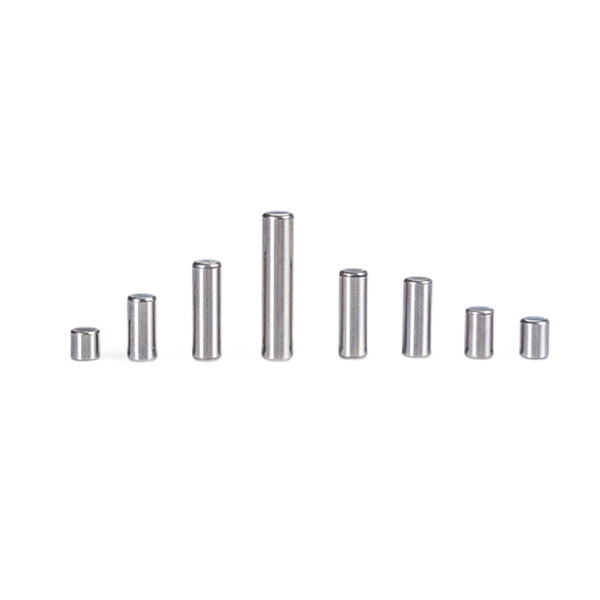6 Series Roller Bearing
Key words:
Bearing | Roller | Roller pin | Pin shaft
Classification:
Description
Name Roller material GCR15, stainless steel hardness HRC60-65 excircle tolerance 2um length tolerance 30um verticality ≤ 15um end face runout ≤ 15um roundness ≤ 1um surface roughness ≤ Ra1umGCr15 refers to a high carbon chromium Bearing steel with less alloy content, which has high hardness, uniform structure, good wear resistance and high contact fatigue performance after quenching and low temperature tempering. Areas of application Bearing rollers, jet nozzles of turbojets, plungers, flaps, bushings, etc.
The Bearing is a very critical component of the motor. It is a key component that connects the stator and rotor of the motor and realizes the conversion of electrical energy and mechanical energy. Ball Bearing and Roller Bearing are Bearing types commonly used in small and medium-sized motors. Ball Bearing is mostly used for low-power motors, while Roller Bearing is used for low-voltage high-power and high-voltage motors.
From the analysis of the contact between the rolling body and the Bearing ferrule, the ball of the ball Bearing is in point contact with the ferrule, and the contact point is a straight line connection when the Bearing is running, while the Roller Bearing is in line contact with the ferrule when the Bearing is running. The contact lines will be connected to form a surface. In view of the contact relationship between the rolling body and the ferrule, we can intuitively judge that the ball Bearing should be relatively stable during operation, that is, the noise during operation is relatively small; relatively speaking, the noise of the Roller Bearing during operation is relatively large, but The carrying capacity is higher than the ball Bearing.
For motors, in more cases, it is necessary to select a suitable Bearing to match various factors such as noise and load in actual use. If you want to have both fish and bear's paws, you may need to make rational choices when necessary.
Introduction of Common Roller Bearing
The single-row Roller Bearing is a separate-type Bearing, often used in small and medium-sized motors. This type of Bearing is easy to install and remove, and both rings can fit closely, correcting the contact line between the Roller and the raceway, which can reduce stress concentration.
The types of Roller Bearing are divided by their rib form. The outer ring of NU-type Bearing has two ribs, and the inner ring has no ribs. The inner ring of N-type Bearing has two ribs, and the outer ring has no ribs.
The outer ring of the Roller Bearing has two ribs and the inner ring has one rib, which can bear axial force in one direction.
Performance comparison of steel and copper cage Bearing
The cage material is required to have the strength to withstand the vibration and impact load in operation, the friction with the ferrule and the rolling body is small, the weight is light, and the characteristics of being able to adapt to the operating temperature. Copper cages and steel cages have their own advantages, but each is not applicable.
1. Steel cage is stronger than copper cage.
2. Small and medium-sized Bearing generally use cold-rolled and hot-rolled steel plates, and brass plates and stainless steel plates can also be used according to the purpose. Large Bearing generally use automobile-made cages, and the materials are mostly structural carbon steel and high-strength brass castings, and also use ductile iron, aluminum alloy and other materials.
3. The antifriction effect and wear resistance of copper are very good.
4. The wear resistance of the steel cage is not as good as that of copper, and it is easy to peel off and stick when rubbing with the rolling body. It is also a magnetic material. The remanence of the Roller Bearing itself in use is difficult to eliminate. The worn iron filings are not easily discharged due to remanence. will increase Bearing wear.
Name | Roller |
Materials | GCR15, stainless steel |
Hardness | HRC60-65 |
External circle tolerance | 2um |
Length tolerance | 30um |
Verticality | ≤ 15um |
End-face runout | ≤15um |
Roundness | ≤ 1um |
surface roughness | ≤ Ra1um |
GCr15It refers to a high-carbon chromium Bearing steel with less alloy content. After quenching and low-temperature tempering, it has high hardness, uniform organization, good wear resistance and high contact fatigue performance.
Application field Bearing roller,turbojet engineNozzle, plunger, valve, bushing, etc.
More Products
Product inquiry
We will contact you within one working day. Please pay attention to your email.
Online message
Welcome to leave your information to get in touch with us!
Manager Wang: +86-13861268538
Manager Jiang: +86-13961180287
E-mail: 13861268538@139.com
Address: No. 209, Huaxing Road, Jintan District, Changzhou City, Jiangsu Province, China.
Copyright © 2024 Changzhou Bangde Bearing Roller Co., Ltd.



